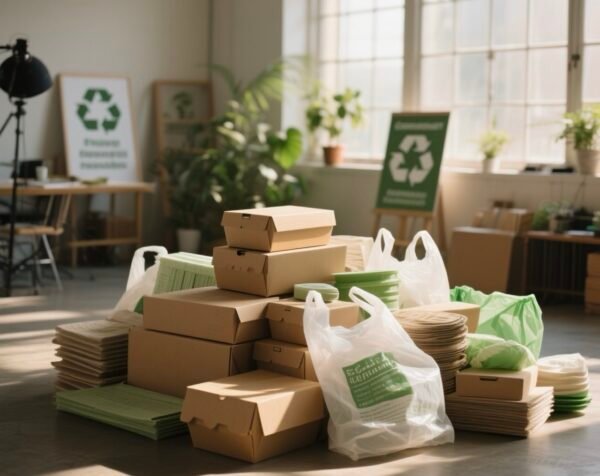Introduction
A biodegradable fork that decomposes in soil within months sounds like a perfect solution to plastic waste. But what if it becomes a breeding ground for bacteria before it even reaches the compost pile? As global industries shift towards sustainable materials, the overlooked reality is that biodegradable does not always mean hygienic.
In recent years, antimicrobial agents – particularly inorganic compounds of silver, copper, and zinc – have emerged as powerful tools to ensure that biodegradable products remain safe, odor-free, and consumer-friendly from factory to end-of-life.
This article dives deep into how antimicrobial agents are transforming the biodegradable materials industry, delivering on both environmental promises and public health needs.
The Hidden Hygiene Problem of Biodegradables
Environmental scientists praise materials like PLA (polylactic acid), PHA, PBAT, and bagasse pulp for their ability to decompose naturally, reducing landfill burden and ocean plastic pollution. However, manufacturers and retailers are discovering unexpected challenges:
- Moisture Attraction
Many plant-based polymers absorb ambient humidity, fostering microbial growth. - Limited Chemical Resistance
Harsh disinfectants can damage biodegradable polymers, making deep cleaning impractical. - Odor Development
Bacterial and fungal growth produces unpleasant smells during storage, transport, or shelf display. - Surface Contamination
Contact with raw materials, human handlers, or humid environments increases microbial loads, raising safety concerns for food-contact products.
For example, biodegradable takeaway boxes in tropical climates often develop musty odors before use, harming brand image and posing hygiene risks.
Antimicrobial Agents: What Are They?
Unlike organic antimicrobials such as plant extracts or chemical disinfectants, inorganic antimicrobial agents are metal-based compounds offering durable, broad-spectrum protection. Key types include:
Silver (Ag)
- Releases Ag+ ions that attack bacterial cell membranes, disrupt enzymes, and inhibit replication.
- Effective against bacteria, fungi, and some viruses at extremely low concentrations.
- Maintains performance over long durations without losing potency.
Copper (Cu)
- Cu2+ ions damage bacterial proteins and DNA through oxidative stress.
- Offers strong antifungal and antiviral properties.
- Functions synergistically with silver to enhance antimicrobial coverage.
Zinc (Zn)
- Zn2+ ions interfere with bacterial metabolic enzymes.
- Provides mild but broad protection.
- Commonly used alongside silver or copper for reinforced effects.
Expert Insight: Why Metals Over Plant Extracts?
Dr. Ren Li, a material science consultant specializing in biopolymers, explains:
“Plantextractsare popular for antimicrobial claims but lack long-term stability. Heat, UV exposure, and moisturedegradetheir efficacy quickly. In contrast, metal ions remain active within polymer matrices for years, offering a reliable, safe solution with minimal environmental impact.”
How Are Antimicrobial Agents Integrated into Biodegradable Products?
- Masterbatch Formulation
Metal-based compounds are blended with biodegradable resin in concentrated masterbatches, ensuring compatibility and uniform distribution. - Extrusion and Molding
During product manufacturing, masterbatches are melt-blended into PLA, PBAT, or bagasse pulp to embed antimicrobial agents throughout the material structure. - Controlled Ion Release
Ions migrate slowly to the product surface, where they interact with microbial cells to kill or inhibit growth without altering material biodegradability.
Success Story: Transforming Compostable Cutlery
The Problem
An eco-tableware brand in Europe faced negative feedback: their PLA cutlery sets developed stale odors and mold spots during shipment to humid regions. Retailers rejected entire batches due to hygiene concerns.
The Solution
The brand integrated a silver-zinc antimicrobial masterbatch into their PLA cutlery production. The formulation was optimized to:
- Maintain the natural transparency and gloss of PLA.
- Release effective yet safe levels of silver and zinc ions.
- Ensure no interference with industrial compostability certifications.
The Impact
✅ 99.9% bacterial reduction confirmed through ISO 22196 testing
✅ No odor development during extended storage in tropical environments
✅ Retail acceptance rate rose by 100%, restoring brand trust
✅ Certification compliance maintained, supporting eco-label marketing
Environmental and Regulatory Considerations
1. Safety and Compliance
Inorganic antimicrobial agents used in biodegradable products are designed to:
- Meet FDA CFR Title 21 food contact standards
- Comply with EU (EC) No. 1935/2004 material safety regulations
- Pass compostability tests ensuring they do not hinder microbial degradation in compost facilities
2. Minimal Environmental Impact
Unlike organic antimicrobials that may require chemical stabilizers or preservatives, metal-based agents:
- Remain embedded within products during use
- Release minimal residues that integrate harmlessly with soil microflora post-degradation
Challenges Ahead
Despite their benefits, integrating antimicrobials into biodegradable products faces hurdles:
| Challenge | Current Solutions |
|---|---|
| Cost Sensitivity | Developing low-dosage high-efficacy formulations to minimize impact on product pricing. |
| Consumer Education | Clear labeling and communication to explain benefits without greenwashing concerns. |
| Regulatory Variability | Formulating region-specific variants to comply with differing food contact and compostability standards. |
Future Horizons: Where Is The Industry Going?
- Smart-Release Antimicrobials
Research is focusing on temperature or moisture-triggered ion release systems for targeted antimicrobial action. - Nano-formulation Enhancements
Nano-silver or nano-copper particles provide greater surface area for improved efficacy at lower concentrations. - Synergistic Multi-metal Systems
Combining silver, copper, and zinc in optimized ratios for broader spectrum protection without increasing cost significantly.
Conclusion: Sustainability Meets Hygiene
Biodegradable materials are vital to reducing our reliance on fossil-fuel plastics, but they must also uphold hygiene and safety standards. Inorganic antimicrobial agents are redefining the future of biodegradable products, ensuring:
- Products stay clean, odor-free, and safe during storage and use
- Environmental goals remain uncompromised, with maintained compostability
- Brands gain a competitive edge by offering consumers both eco-friendliness and health protection
In the journey towards greener living, antimicrobial agents ensure that our solutions are not just sustainable, but truly beneficial for human well-being.
✉️ Looking to Enhance Your Biodegradable Product Range?
We provide advanced inorganic antimicrobial solutions tailored for PLA, PBAT, bagasse pulp, and other biopolymers.
Contact our team to learn how you can elevate your products with sustainable, safe, and market-leading antimicrobial protection.


-300x210.jpg)
